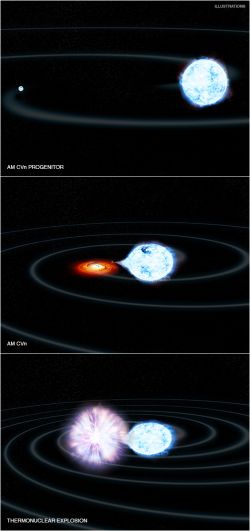 Despite being known for almost 50 years, the question has remained: where do AM CVn systems come from? New X-ray and optical observations have begun to answer that with the discovery of the first known systems of double stars that astronomers think will evolve into AM CVn systems.
Despite being known for almost 50 years, the question has remained: where do AM CVn systems come from? New X-ray and optical observations have begun to answer that with the discovery of the first known systems of double stars that astronomers think will evolve into AM CVn systems.
AM CVn systems are of interest to scientists because they are predicted to be sources of gravitational waves. This is important because even though such waves have yet to be detected, many scientists and engineers are working on instruments that should be able to detect them in the near future. This will open a significant new observational window to the universe.
The paper reporting these results is available online and is published in the Monthly Notices of the Royal Astronomical Society Letters. The authors are Mukremin Kilic, from the University of Oklahoma in Norman, OK; J.J. Hermes from the University of Texas at Austin in TX; Alexandros Gianninas from the University of Oklahoma; Warren Brown from Smithsonian Astrophysical Observatory in Cambridge, MA; Craig Heinke from University of Alberta, in Edmonton, Canada; Marcel Agüeros from Columbia University in New York, NY; Paul Chote and Denis Sullivan from Victoria University of Wellington, New Zealand; and Keaton Bell and Samuel Harrold from University of Texas at Austin.

